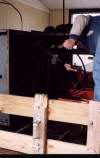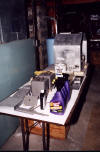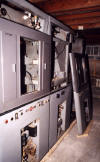|
WB2SYQ's
Collins 21E Adventure
Paul K2ORC
Click on thumbnails to enlarge
Before checking in to see how the WB2SYQ 21E Adventure
is
progressing, please take a couple of extra minutes and cut
and paste the URL in the next paragraph in your browser.
It is the web site address of station KSTN, Stockton,
California, broadcasting at 5 kw daytime, 1 kw after dark
on 1420 kHz. During the day, KSTN-AM still uses a Collins
21E that the station purchased new in 1955. From the
pictures on their web site, it sure looks like KSTN is
proud of their Collins 21E... and of the station's three
towers, erected without a crane in 1946. It is wonderful
to see this kind of equipment still in use!
Here is the KSTN URL.
http://www.kstn.net/tour1.htm
(When you're finished visiting KSTN's site, click your
browser's BACK arrow so you can return here to read Chapter
6 of WB2SYQ's Collins 21E Adventure.)
------------------------
|
Chapter 6
Update Early June, 2002
Welcome back to a basement in Endicott, New York, a place we're all
getting to know rather well, where a Collins 21E, rescued from a date with
a scrap yard, is being restored.
As this is written, it's a bit over three months since the cabinets were
lowered into Norm's basement. Even though he's not ready to light up the
filaments yet, he has been a busy ham.
There is a little history to add. It appears, that this21E, serial number
47, was built in 1956 and its original owner was WTSN, 1270 kHz, Dover,
New Hampshire which only ran it at 1 kw. As will be recalled, WEBO only
ran this
21E at 500 watts.
A vintage BC transmitter really should have a vintage audio console and to
that end, there's been an addition: Norm has acquired a Gates "Producer"
which had until recently
been used as an audio mixer in an area college's film making department.
If anyone has a manual, or a clean copy of one, for the Gates "Producer",
Norm is looking for one.

As those who've read accounts of other BC transmitter restorations -- or
who have performed them -- know, one of the biggest initial chores facing
a vintage BC transmitter's new owner is plain, old cleaning. Many of
these old beauties have been standing untouched in less than pristine
surroundings for a considerable time. Dust, grime, cobwebs, dead bugs,
mouse souvenirs and other debris
mixes with oil, perhaps from leaking caps or blown transformers, not to
mention the residue of years of routine parts lubes. This mixture can
create a formidable layer of nasty crud which must be removed before
further
work can be done.
Norm's 21E, despite having been in its old station's transmitter building,
was pretty dirty. Because of the unusually warm temperatures this past
February, two of the cabinets made a stop at an Owego car wash before
continuing
on to Endicott. The stake body truck was driven into a bay at the car
wash and in front of several interested spectators, Norm hosed out the
cabinets.

Drastic? Actually not. Several others who've undertaken transmitter
restorations have web sites, or have written articles with pictures and
discussions describing how a transmitter was given a thorough washing
before it was
brought into its new home. But water alone wasn't going to get rid of oil
and grease, so chemicals entered the picture. You can see a few bottles
from one of the cases of
degreasing cleaners Norm's been depleting as he's chase dafter heavy duty
crud.

One of the heaviest cleaning chores to date is the one being undertaken at
this time: the blower motor. Mounted in the bottom of the PA cabinet, the
blower motor has wool (yes, wool as in sheep) packed bearings over which
cups are mounted into which lubricating oil is applied.
|
|
.The 21E manual
suggests the wool packing be checked weekly to make sure it isn't drying
out and a regular schedule be established for oiling. It appears that oil
was applied regularly, and over time, the excess spattered not only over
the blower motor, but the bottom of the PA cabinet.
Lot's of degreasing will be going on there, and since the warm weather is
here, most of it will be done outdoors. The PA cabinet is the one with the
door leaning against it in the photo showing the three cabinets, by the
way.
The exteriors of the cabinets are cleaned and upright in the basement,
side by side in operating position, each sitting on a wooden platform.
The platform gets the cabinets off the basement's cement floor to prevent
corrosion and provide some protection in case -- heaven forbid -- water
should ever get into the basement. The only
obstruction to getting the cabinets in position was a porcelain light
socket, easily rewired and moved to another location. Norm also hung a
fluorescent light fixture from the joists at the rear of the cabinets for
better illumination. Note that parts reference numbers have been written
in Magic Marker above or below some parts. Good
idea for keeping track of what goes where.

The 21E came with a complete, original (and somewhat shopworn)
"Instruction Book", another bit of good fortune since a 21E manual
recently showed up for sale on a BC equipment dealer's web site for $95.
Each page of the
Instruction Book is now inside an individual plastic protector sleeve and
the sleeves are kept in a zippered three-ring binder.

Components that had been removed are still spread out in the basement,
some cleaned and checked over, some still awaiting cleaning, others set
aside for repair or replacement. Fortunately, none of the 21E's
transformers fall into the latter category. The plate transformer that
came with the 21E when Norm bought it, came from Peter
Dahl, purchased new shortly before the transmitter was taken off the air
in October 2000. Norm found, on inspection, evidence of some arcing on
the mod. reactor. He has now replaced the insulators on the reactor
with a
pair of new porcelain insulators, a bit larger than the originals. A bit
of custom drilling and the thing is better than new.
The two Eimac 3CX3000's from the mod. deck had been replaced with rebuilt
ones (Pentalab charges $400 a pop to rebuild them) at about the same time
as the plate transformer. Run class AB1 they are able to develop 2,500
watts of audio to fully modulate the final, a 3CX2500. The single 3CX2500,
which is run class C is capable of the full 5 kw for which the 21E rated.
The 21E uses four 4-125 driver tubes. A 6AU6 oscillatorn drives the first
buffer 6SJ7 which drives an 807 which drives the grids of a pair of 4-125
RF drivers which in turn drive the grids of the two 3CX3000 modulator
tubes running push-pull. The other 4-125 pair drive the 3CX2500.
Several small mechanical repairs have been completed, including that of a
remote coupling linkage for the final adjustments of one of the plate caps
in the tank circuit. Norm had to fabricate a new fastener on one end
coupler
when the when the old one broke off while it was being removed.

Stay tuned for the next installment of WB2SYQ's 21E
Adventure!
Back ECS
Next Home |